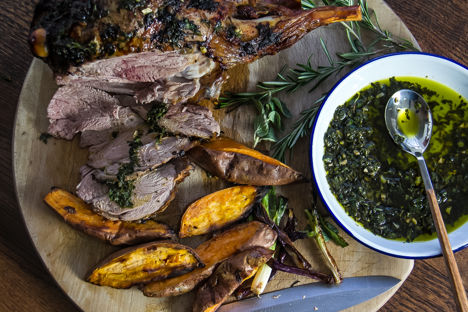
El cordero: lamb in Latin America
From Mexican barbacoa to Argentinian asado, lamb is the meat of choice in many parts of Latin America. Discover some of the most celebrated dishes and recreate them in your kitchen at home.
El cordero: lamb in Latin America
From Mexican barbacoa to Argentinian asado, lamb is the meat of choice in many parts of Latin America. Discover some of the most celebrated dishes and recreate them in your kitchen at home.
What springs to mind when you think of lamb? A whole roast leg, studded with rosemary and garlic, perhaps? Or maybe a rich, warming curry full of spices and chilli? Lamb is a clear favourite in the UK, but in other countries it is seen as a much more exotic meat. In the US, nearly fifty percent of people have never even tasted it, while in Japan it is only usually served as part of a meal called ‘Genghis Khan’ on Hokkaido island, where cuts are barbecued in front of diners at the table.
In much of Central and South America, however, lamb is a common sight in restaurants, shops and kitchens. There are a few exceptions (the meat is a rare find in Brazil and some countries will almost always use goat instead) but in places like Argentina, Chile, Uruguay, Peru and Ecuador, you’ll find it gently roasting over open fires, being slow-cooked into rich, comforting stews or stuffed inside little pastries as a roadside snack. Patagonia – the region at the southern tip of South America that straddles both Chile and Argentina – is famous for its sheep farms, where you can see horse-riding gauchos (cowboys) round up sheep throughout the vast plains of the area.
As you’d expect, the flavours and ingredients used to accompany lamb in Latin America are very different from what we tend to go for in the UK. Herbs and spices with plenty of heat and tang are used to cut through the fattiness of lamb and, while some are familiar, others are a little more exotic and the perfect way to try something new when preparing lamb at home. Here are some of the most popular dishes from Central and South America.
Cordero a la barbacoa en adobo
Cordero means lamb, barbacoa means barbecue and adobo means marinade, so you can already begin to imagine how this dish is prepared. Traditionally from the central regions of Mexico, this ancient cooking technique was used to cook whole lamb or sheep and required a pit to be dug in the ground that was filled with hot coals and covered with cactus-like leaves called maguey. While we have no doubt going to these lengths would provide you with some very tasty meat, nowadays barbacoa tends to refer to a shoulder or leg of lamb wrapped in banana leaves or foil and slow-cooked until falling apart and meltingly tender.
The adobo is quintessentially Mexican in flavour – several different varieties of chillies are toasted and blended into a paste with tomatoes, cumin, onion and garlic, which is then smeared all over the meat and left overnight to infuse. Once cooked, the meat is shredded and traditionally served in soft tacos with salsa, onions and lime.
Seco de cordero
Seco actually means ‘dry’ in Spanish, but in Peru and Ecuador it refers to a stew. Originating in the north of Peru, diced lamb is marinated in beer, which helps break the meat down, and flavoured with lots of coriander and ají amarillo chilies – a fruity, bright orange variety that’s used throughout Peruvian cuisine. In Ecuador, achiote powder (ground annatto seeds) and panela (unrefined cane sugar) are sometimes included as well, turning the sauce from a fresh, vibrant green to a deep, sweeter red.
Cordero al asador
Asado is a full-on event in Argentina and other South American countries, where friends and family get together and cook all sorts of meats over an open wood fire. The asador is the person cooking all the food, carefully tending to the flames and ensuring the meat is regularly turned and evenly cooked. An asado can centre around lamb, beef or goat or a mixture of all three.
While the meat itself – in this case lamb – is usually cooked without a marinade, the accompanying chimichurri sauce is a vital part of any asado. This simple dressing of oil, vinegar, garlic and fresh herbs is full of zingy, tangy flavours and is poured generously over the meat before serving. Some asadors will brush the lamb with some of the chimichurri right before cooking, especially if it’s being cooked in an oven rather than an open fire or barbecue. Served with roast sweet potatoes, this is one of the signature dishes of Argentinian cuisine.
Empanadas de cordero
While empanadas are enjoyed all over Latin America (particularly Argentina), in Patagonia they are most commonly filled with finely chopped lamb. These little baked or fried pasty-like snacks originated in Galicia, Spain, and there are now dozens of variations on both the dough (which can be made from corn, wheat or even bread) and the fillings (which can range from beef with raisins and olives to spicy tuna). At the southernmost tip of South America, however, lamb is the filling of choice, which is often flavoured with honey, garlic, paprika and fresh herbs.

